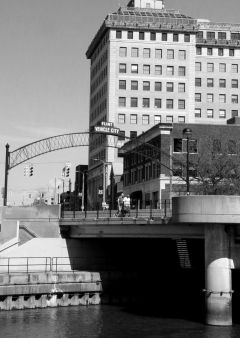By Harold C. Ford
“You’re either part of the solution or you’re part of the problem.”- Eldridge Cleaver
“What I learned…was that my goal wasn’t to build a house. It was to transform myself by building a house.”- author Drew Philp, A $500 House in Detroit, Rebuilding an Abandoned Home and an American City, 2017, Scribner
 Don’t buy Drew Philp’s book, A $500 House in Detroit,if all you’re looking for is how-to-do-it lessons on resurrecting an utterly abandoned shell of a house in a mostly empty neighborhood in a major American city. You’re better off visiting the local library, the local household goods stores, or accessing online videos as Philp did.
Don’t buy Drew Philp’s book, A $500 House in Detroit,if all you’re looking for is how-to-do-it lessons on resurrecting an utterly abandoned shell of a house in a mostly empty neighborhood in a major American city. You’re better off visiting the local library, the local household goods stores, or accessing online videos as Philp did.
Indeed, Philp provides summary overviews of building a chimney from salvaged bricks, rebuilding a foundation, installing wallboard, plumbing, and windows. He piggybacks descriptions of these projects with sharp, historical analysis of the social, economic, and political forces that inhabit his building materials and the challenged city that he adopts. Take, for example, his reflection on the water that, after great labor, he provides to his thirsty home:
“The water had made a journey of thousands of miles and years to be trapped in little plastic tubes running to my faucet. In principal it was a rather simple system—just cylinders to carry water around—but in practice it spanned the globe and the weather and thousands of years, from the copper miner in Peru, to the Roman aqueduct engineer, to the Chinese workers making plastic pipes, to the miracle of evaporation, climate change, and the Ice Age, to the cup I held in my hand as my father, smiling, watched me draw from my brand-new old kitchen sink the first water that had run through my house in a decade.”
Buying a house:
In 2009, Philp was a self-described “well-read twenty-one-year-old white kid” who thought he could “marry my education with my general knowledge of repairing things and fix the biggest project, the ailing city (Detroit) that had loomed over my childhood.”
The 20 or so people who attended a book club meeting at the Flint Public Library in January had a chance to meet Philp in person and learn more about him and the history of his book.
“I’m a blue collar kid from Adrian, Michigan about 70 miles southwest of Detroit,” he told them.

Philp at the Flint Public Library (Photo by Harold Ford)
A decade earlier he had been traveling back and forth from jobs in Detroit to the University of Michigan in Ann Arbor where he was nearing completion of a four-year degree.
He described as serendipitous, a Halloween party conversation between himself, dressed as an organ grinder, and Will, dressed as a monkey. Will had just purchased a home in Detroit for $3,000.
That sparked an idea for Philp who had been sanding wooden floors in Detroit houses for $8.50 an hour. “Working in these houses got me thinking, ‘Oh, I should buy one of these houses, they’re really cheap, right now, and stay here because it will keep me here.’”
“I moved to Detroit because I could have an impact,” he told FPL patrons. “If I had a house, if I bought a house, if I put my blood sweat and tears into that house, I wouldn’t be able to leave.”
Philp’s decade-long sojourn that began with considerable idealism and naïveté was oft-tempered by sparse resources and the harsh realities of his mission:
“I felt old and rusty, like my truck, surprised at what was holding me together. My credit card was maxed out,” he said. “I didn’t have a dollar to my name. Most of my words were curses, the only thing ready at the lips. I was hungry and cold, mentally, physically and emotionally tired.”
Street level view:
Turning away from the more comfortable path that his privilege and education may have afforded him, Philp fashioned a way to respond to the all-consuming blob of American capitalism that mesmerizes the masses with shiny gadgets and phony culture. He staked a claim along a nearly dead artery of a great, but diminished, American city and board by board, window by window, breathed life into the decrepit hull of a house.
$500 House details the way Philp and his neighbors resurrected their Poletown neighborhood using agriculture, arts, and community. It’s largely, but not entirely, a microcosmic, street level story of human tribes, their amazing achievements and monumental missteps, as they create and abandon cities and civilizations.
Detroit’s 21st century plight was precisely why Philp landed there. “Nowhere was America’s fight for its soul clearer than in what was the Motor City,” he wrote. “Politics wasn’t going to fix things any longer. We’d have to do it ourselves.”
Romance and realism:
$500 House is more than nails, cement blocks, and hammers. Philp’s monomaniacal focus on his new home is broken one summer when he meets Cecilia, an architect from Italy. Their budding romance is consummated during a visit to Belle Isle and described in a steamy departure from the rest of the account.
“I ran my hand under her shirt, my rough fingers along the smooth olive skin of her back. I gently pressed her against the ground and moved my hand around her body to her breast. She closed her eyes and arched her back and we were one.”
The affair painfully ends when Cecilia told him, “I have a life in Italy, a house, a boyfriend. We are engaged.” Romantic reality check.
Philp’s pioneer spirit is further chastened by the reality of violent crime. A neighbor advises him:
“If someone has the audacity to come into your house, they have the audacity to kill you. You have to protect yourself.”
Eventually there’s “a knock on the door” in the dead of the night followed by someone trying to kick in the front door to gain entry. Philp grabbed the shotgun given him by his father and shouted, “I’m going to blow your head off, motherfucker.” The invader departed.
“I knew that man outside wasn’t my enemy,” wrote Philp. “My enemy was the addiction stunting my community and the lack of help for it…the desperation we’ve allowed to ferment within our brothers and sisters.”
Potshots and shoutouts:
Philp is unambiguous about what he disdains: freeway construction and urban renewal; arsonists; pretentious ruin porn artists; privileged culture as found in Ann Arbor and at the University of Michigan; banks; useless wars; restrictive covenants in suburban communities; big box stores like Walmart; emergency managers; tax breaks for sports cathedrals; environmental racism; consumerism and planned obsolescence.
The 290 pages of his book find joyousness in: recycling; nature; light; industriousness; neighbors; pets; home ownership; agriculture and gardens.
Parting shots:
Detroit’s historic bankruptcy resonates with Philp as a seminal moment in 21st century America:
“The bankruptcy marked the first shots in the battle for Detroit’s soul,” he writes. “On one side stood the old methods of cold economics and scale, and on the other a grassroots movement of education, community, and compassion.”
“The fight is against the corruption of the bosses, the politicians, the moneymen, those who perpetuate inequality, racism, and antidemocracy for their own gain.”
Finally, Philp leaves the reader with some optimism and resolve in the final pages of his book:
“I find hope within the sanctuary of the walls of this house, nailed into each and every board I placed myself, screwed into every light switch, flowing out of each faucet.”
“I know that I did the best I could with what I had. Our only failure can be trying nothing new. I haven’t given up yet, and the game ain’t over. I live free. I’m still here.”
EVM Staff Writer Harold C. Ford can be reached at hcford1185@gmail.com.


You must be logged in to post a comment.